Under the garden
Not very many items on this page (although gradually increasing!) - but it seemed inappropriate either to mix a heap of old rubbish in with the birds, bees and flowers, or to photograph every bit of old metal, broken glass and other junk.
However, we have found several interesting or odd items whilst digging in the garden. One area, at a decent throwing distance from the back door, obviously used to be the old rubbish heap, or midden. Dustmen (or "Waste Management Operatives") now call regularly but at one time, the heap in the garden was the only place for anything that couldn't be mended, re-used or composted. This heap had a large ash tree growing on it until a few years ago. The tree had to be felled, because a fungal infection meant that it could soon become dangerous. It was when trying to remove the stump and roots that we discovered that it was growing on a heap of broken bricks and bent metal. As we removed more roots, we found several intact bottles and pots.
Part of the garden was at one time included within the garden of the farmhouse next door. That house is much older (probably dating from about 1700) and would have been occupied by considerably better-off people than the labourers in the cottages. This might account for one or two of the originally higher value items we found.
Another source of several bits was a heap at the bottom of the garden. A large heap which at first appeared to be the old bonfire place needed moving because it was pushing over the adjacent fence. It was immediately evident that the heap mostly comprised broken bricks, tiles, glass and other debris. This had presumably been put there when the cottages had been converted to a single dwelling. Amongst this debris were a few items of interest, including the metal plate illustrating the Pythagorean theorem.
One or two other items were found in the process of digging other areas, simply mixed into the soil. The entire garden seems to have a significant amount of broken brick and glass. The odd artefacts make all the time spent collecting broken glass seem worthwhile.
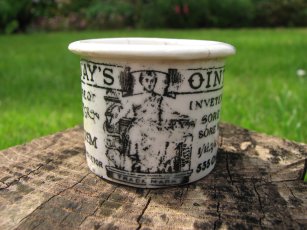 This pot contained Holloway's Ointment. This was obviously a most wonderful material - the wording on the jar reads:
This pot contained Holloway's Ointment. This was obviously a most wonderful material - the wording on the jar reads: "HOLLOWAY'S OINTMENT
For the cure of
GOUT
and
RHEUMATISM
INVETERATE ULCERS
SORE BREASTS
SORE HEADS, BAD LEGS &c
1/1½, 2/9, 4/6, 11/-, 22/-, & 33/- Pr Pot.
Manufactured Only By The Proprietor
533 Oxford St London
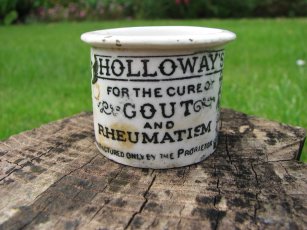
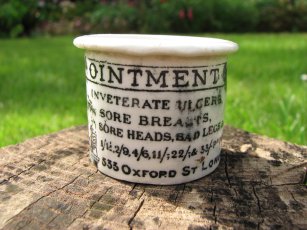 Here are the right and left sides of the jar.
Here are the right and left sides of the jar.Information from the internet says that Holloway's was situated at the 533 Oxford St address from 1868-1881, and that Thomas Holloway, having made a fortune from sale of his ointment and pills in Britain and abroad, founded a college for women, the Royal Holloway College, which was opened by Queen Victoria in 1886..
 This metal object looks as if it might be silver. The shape within the frame is a representation of Euclid's first geometric proof of the Pythagorean thoerem. The holes in the two corners look as if it might have been hung on a chain to be worn around the neck. The teachings of Pythagoras influenced socieies such as the rosicrucians and the freemasons, but I have not been able to find evidence that this symbol is important to either of these groups. If you have any ideas, please contact us.
This metal object looks as if it might be silver. The shape within the frame is a representation of Euclid's first geometric proof of the Pythagorean thoerem. The holes in the two corners look as if it might have been hung on a chain to be worn around the neck. The teachings of Pythagoras influenced socieies such as the rosicrucians and the freemasons, but I have not been able to find evidence that this symbol is important to either of these groups. If you have any ideas, please contact us.
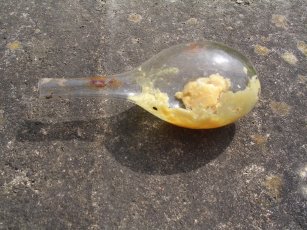 When digging out part of the old midden, we found this odd shaped bottle. Although it was not sealed, the long neck had prevented soil from running in. Part of the inside of the bottle was coated with a layer of pale yellow wax. We tried heating a small piece of wax - it melted, and smelled "like wax crayons" according to John. Maybe a hint of beeswax, but not strongly so.
When digging out part of the old midden, we found this odd shaped bottle. Although it was not sealed, the long neck had prevented soil from running in. Part of the inside of the bottle was coated with a layer of pale yellow wax. We tried heating a small piece of wax - it melted, and smelled "like wax crayons" according to John. Maybe a hint of beeswax, but not strongly so.The bottle was found at the lowest level of the excavation we made - but, as this was to one side of the midden, it is possible that it may have been more recent than some other items.
So we are left wondering what the bottle was for, what the wax is, and why it was in this bottle? Again, please let us know if you have any ideas.
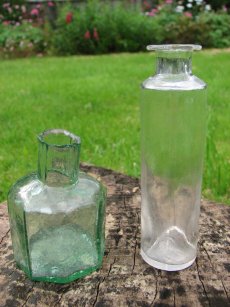 These two bottles also came from the old midden heap. The one on the left (probably an ink bottle) was obviously removed from the mould before it was quite hard enough. If you click on the image to see the full size version (you may also have to click again to tell your browser not to try to fit it into the browser window), you can see the bubbles and ripples in the glass of this little bottle.
These two bottles also came from the old midden heap. The one on the left (probably an ink bottle) was obviously removed from the mould before it was quite hard enough. If you click on the image to see the full size version (you may also have to click again to tell your browser not to try to fit it into the browser window), you can see the bubbles and ripples in the glass of this little bottle.
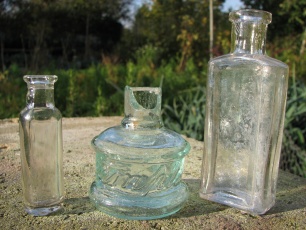 Three more small bottles dug up in the garden, this time from an area adjacent to the vegetable plot, found mixed with ash and bits of broken brick and tile - possibly another midden area, but also maybe laid as a hard base for a pathway. The one in the middle has the word "Temple" and looks like an ink bottle.
Three more small bottles dug up in the garden, this time from an area adjacent to the vegetable plot, found mixed with ash and bits of broken brick and tile - possibly another midden area, but also maybe laid as a hard base for a pathway. The one in the middle has the word "Temple" and looks like an ink bottle.
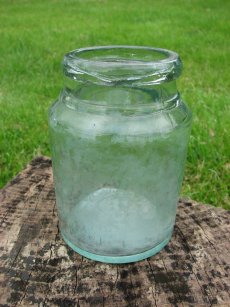 On first sight, this glass jar looks like a modern jam jar. It is 11cm high x 7.5cm diameter, so about the same as a modern 1lb jar - but the glass is very much thicker than either modern jars, or those common about 40 years ago. This jar weighs 408 grams when empty. If you click on the image to see the full size version, you can see that the body was formed in a two-part mould, but that the rim was added afterwards, by hand.
On first sight, this glass jar looks like a modern jam jar. It is 11cm high x 7.5cm diameter, so about the same as a modern 1lb jar - but the glass is very much thicker than either modern jars, or those common about 40 years ago. This jar weighs 408 grams when empty. If you click on the image to see the full size version, you can see that the body was formed in a two-part mould, but that the rim was added afterwards, by hand.We also found a small jar of the type used for meat paste and a ceramic jar.
 At one point in the midden heap, we found an old brass buckle. Then another, then several more. A few of them had remnants of rotten leather attached, but so little that it was not possible to tell what the original item had been. We think the buckles in the photo are all that were there - but there are a surprising range of different sizes and styles. They were all in one area, so we assume that they all came from a single harness - but, if you know better, please let us know.
At one point in the midden heap, we found an old brass buckle. Then another, then several more. A few of them had remnants of rotten leather attached, but so little that it was not possible to tell what the original item had been. We think the buckles in the photo are all that were there - but there are a surprising range of different sizes and styles. They were all in one area, so we assume that they all came from a single harness - but, if you know better, please let us know.
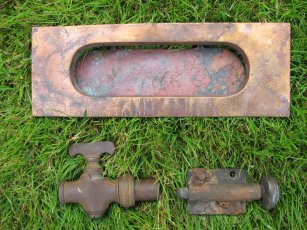 These items all came from the area at the bottom of the garden used as a burning place and tip for old building debris. The three original cottages each had a front door which opened into the front room. These doorways and doors are now all gone, but perhaps this letterbox came from one of them.
These items all came from the area at the bottom of the garden used as a burning place and tip for old building debris. The three original cottages each had a front door which opened into the front room. These doorways and doors are now all gone, but perhaps this letterbox came from one of them.The brass tap may have been a gas tap, perhaps going to the gas light in one of the houses. The catch could have come from a cupboard door, or perhaps a window.
We also found a couple of clock bits - a key from a small clock, and what may be the ring from the top of a small clock?
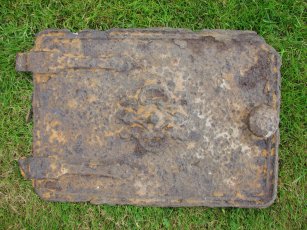 This iron door was dug up from the vegetable plot. It is a similar size to the door on a small range cooker still present in the front room of one of the cottages. This door is 24 x 36 cm. The range in the front room stands just 62cm high and is 92cm wide.
This iron door was dug up from the vegetable plot. It is a similar size to the door on a small range cooker still present in the front room of one of the cottages. This door is 24 x 36 cm. The range in the front room stands just 62cm high and is 92cm wide.
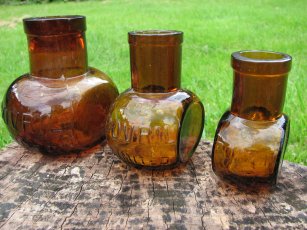 These three jars originally contained Bovril meat extract. They are marked as 8oz, 4oz and 2oz sizes.
These three jars originally contained Bovril meat extract. They are marked as 8oz, 4oz and 2oz sizes.
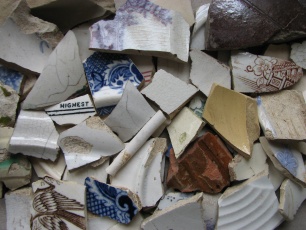 Although we promised not to include photos of every bit of old rubbish, this heap of pottery fragments accumulated over quite some time (removed when digging flowerbeds and the vegetable garden) and gives an idea of the range of pots that must have been thrown out over the years. The red-striped piece could be 1950's, but the broken pipestem and the faded blue and white piece look much older.
Although we promised not to include photos of every bit of old rubbish, this heap of pottery fragments accumulated over quite some time (removed when digging flowerbeds and the vegetable garden) and gives an idea of the range of pots that must have been thrown out over the years. The red-striped piece could be 1950's, but the broken pipestem and the faded blue and white piece look much older.
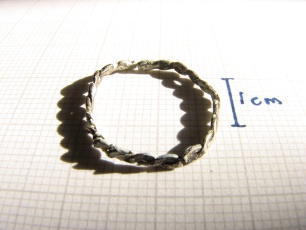 This ring was in the heap at the bottom of the garden, so may well have come from the cottages. The tarnish on it suggests that it is real silver, but we've not had it tested. It is formed of two strands of wire, flattened together. We have no idea of its age - but it was probably very valuable to its original owner.
This ring was in the heap at the bottom of the garden, so may well have come from the cottages. The tarnish on it suggests that it is real silver, but we've not had it tested. It is formed of two strands of wire, flattened together. We have no idea of its age - but it was probably very valuable to its original owner.
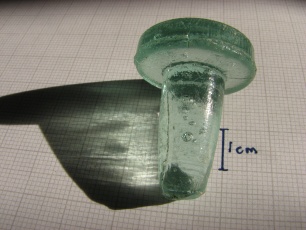 An old glass bottle stopper - these are obviously much tougher than the bottles they originally inhabited, so are commonly found on old midden sites - but we've only found this one in the garden so far, despite finding loads of broken glass.
An old glass bottle stopper - these are obviously much tougher than the bottles they originally inhabited, so are commonly found on old midden sites - but we've only found this one in the garden so far, despite finding loads of broken glass.
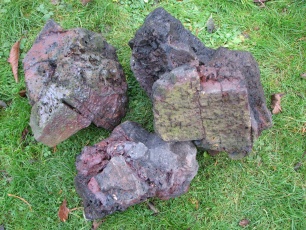 These lumps of bricks obviously melted together as a result of overheating in the kiln when they were made. The fact that they were in our garden suggests that bricks for either the cottages or, more likely, the 1700's farmhouse next door, were made on site. The area around the village of Pembury has clay subsoil, and a part of the village about half a mile away was once occupied by the Pembury brickworks. It is reputed that it was sited there because the clay there was particularly well suited to brickmaking. It is difficult, however, to imagine that these lumps of molten brick would have been transported from there to our garden - hence our thought that they must have been fired on site.
These lumps of bricks obviously melted together as a result of overheating in the kiln when they were made. The fact that they were in our garden suggests that bricks for either the cottages or, more likely, the 1700's farmhouse next door, were made on site. The area around the village of Pembury has clay subsoil, and a part of the village about half a mile away was once occupied by the Pembury brickworks. It is reputed that it was sited there because the clay there was particularly well suited to brickmaking. It is difficult, however, to imagine that these lumps of molten brick would have been transported from there to our garden - hence our thought that they must have been fired on site.
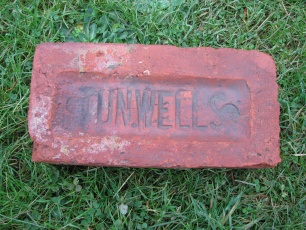 Tunbridge Wells brickworks also made bricks used here - as evinced by this brick found in the garden.
Tunbridge Wells brickworks also made bricks used here - as evinced by this brick found in the garden.
We also have one brick with a "Pembury" mark - it used to be set in the brick paving near the house with the mark visible, but was turned over by workmen who relaid those bricks a few years ago, hence no photo.
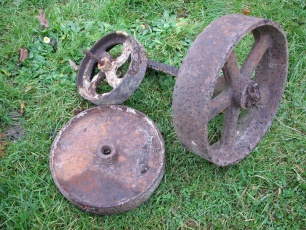 These old iron wheels came from the old rubble heap/bonfire at the end of the garden. They are all fairly small, so probably originate from barrows rather than heavier carts or machinery. It is just possible that the two larger ones might have been from belt driven machinery, but we have found no other evidence of such machines, so think it unlikely.
These old iron wheels came from the old rubble heap/bonfire at the end of the garden. They are all fairly small, so probably originate from barrows rather than heavier carts or machinery. It is just possible that the two larger ones might have been from belt driven machinery, but we have found no other evidence of such machines, so think it unlikely.
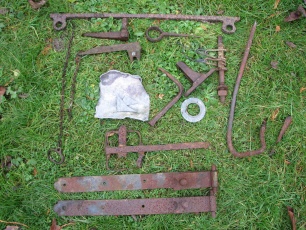 Several other odd metal items also came from the old rubble heap/bonfire area. They might all be considered junk, but also give some clues to the history of the cottages. They include (working approximately from top left to bottom right of the photo) a bar of unknown origin; a spiked hinge support from an old doorframe; a spiked loop of unknown purpose; the chain, handle and part of the mechanism from an old lavatory cistern; some fragments of lead flashing; a bent metal spike (possibly a large nail); a cast iron support, probably part of an old bedstead; the support for an overhead wire, possible a telephone or power line; the brass washer from the underside of the plughole fittings from an old sink or washbasin; another long metal spike; a gin-trap; two old door hinges.
Several other odd metal items also came from the old rubble heap/bonfire area. They might all be considered junk, but also give some clues to the history of the cottages. They include (working approximately from top left to bottom right of the photo) a bar of unknown origin; a spiked hinge support from an old doorframe; a spiked loop of unknown purpose; the chain, handle and part of the mechanism from an old lavatory cistern; some fragments of lead flashing; a bent metal spike (possibly a large nail); a cast iron support, probably part of an old bedstead; the support for an overhead wire, possible a telephone or power line; the brass washer from the underside of the plughole fittings from an old sink or washbasin; another long metal spike; a gin-trap; two old door hinges.
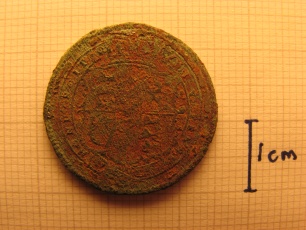
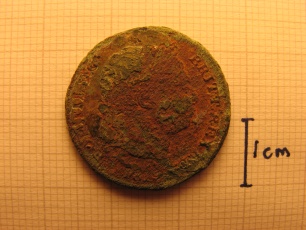 This counterfeit George III shilling appeared when we were digging the vegetable garden. At first, it looked more like an old halfpenny, but the fragments of silver plating soon made it clear that it was not a normal old coin. It is so corroded that the wording is very difficult to make out but, on the "head" side it reads (reading up the left side) "GEOR:III D:G:" and (on the right side, reading downwards) "BRITT:REX F:D:", and I think it shows the date as 1819. On the tail side it says (reading clockwise from the lower left) "HONI . SOIT . Q" and then (after the crown of the coat of arms) "MAL . Y . PENSE ...:..."
This counterfeit George III shilling appeared when we were digging the vegetable garden. At first, it looked more like an old halfpenny, but the fragments of silver plating soon made it clear that it was not a normal old coin. It is so corroded that the wording is very difficult to make out but, on the "head" side it reads (reading up the left side) "GEOR:III D:G:" and (on the right side, reading downwards) "BRITT:REX F:D:", and I think it shows the date as 1819. On the tail side it says (reading clockwise from the lower left) "HONI . SOIT . Q" and then (after the crown of the coat of arms) "MAL . Y . PENSE ...:..."
Click on the photos to see a much larger version, where you can make out much of the wording, and can also see the few remaining areas of silver plating a little more clearly. The odd orange colour of these photographs results from taking them in artificial light - it should be possible to correct the white balance, but my few attempts at this resulted in a severe green cast to the coin itself, and seemed to make the writing even less legible. If I get the right kind of sunlight I might have a go at re-taking these photographs.
A much better example, plus some useful information on forged George II coins is at www.predecimal.com/forged/georgeiii.htm.
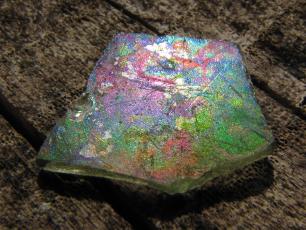 This is a fragment of old glass which we found when digging the vegetable patch. This one shows unusually bright colours arising from corrosion by the water in the soil.It would be nice to know how old it is. This photograph shows sunlight reflecting off the corroded surface, but we've cropped a section out of this image in case you'd like it as a desktop background; you'll find it on normal and widescreen version on our Desktop Backgrounds page
This is a fragment of old glass which we found when digging the vegetable patch. This one shows unusually bright colours arising from corrosion by the water in the soil.It would be nice to know how old it is. This photograph shows sunlight reflecting off the corroded surface, but we've cropped a section out of this image in case you'd like it as a desktop background; you'll find it on normal and widescreen version on our Desktop Backgrounds page